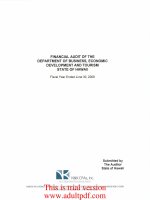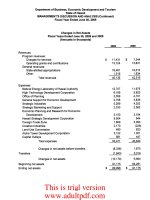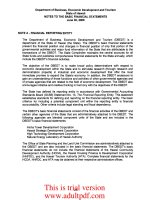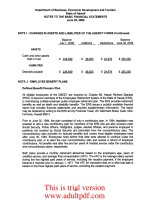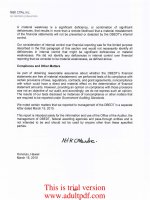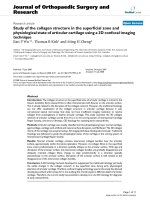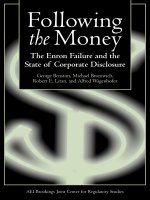benston et al - following the money; the enron failure and the state of the corporate disclosure (2003)
Bạn đang xem bản rút gọn của tài liệu. Xem và tải ngay bản đầy đủ của tài liệu tại đây (1.05 MB, 135 trang )
the
AEI-Brookings Joint Center for Regulatory Studies
Following
the Money
The Enron Failure and the
State of Corporate Disclosure
George Benston, Michael Bromwich,
Robert E. Litan, and Alfred Wagenhofer
Following
the Money
00-0890-FM 1/30/03 9:33 AM Page i
Following
the Money
The Enron Failure
and the State of
Corporate Disclosure
George Benston
Michael Bromwich
Robert E. Litan
Alfred Wagenhofer
-
Washington, D.C.
00-0890-FM 1/30/03 9:33 AM Page iii
Copyright © 2003 by AEI-Brookings Joint Center for Regulatory Studies, the
American Enterprise Institute for Public Policy Research, Washington, D.C., and
the Brookings Institution, Washington, D.C. All rights reserved. No part of this
publication may be used or reproduced in any manner whatsoever without per-
mission in writing from the AEI-Brookings Joint Center, except in the case of
brief quotations embodied in news articles, critical articles, or reviews.
Following the Money may be ordered from:
Brookings Institution Press
1775 Massachusetts Avenue, N.W.
Washington, D.C. 20036
Tel.: (800) 275-1447 or (202) 797-6258
Fax: (202) 797-6004
www.brookings.edu
Library of Congress Cataloging-in-Publication data
Following the money : the Enron failure and the state of corporate
disclosure / George Benston . . . [et al.].
p. cm.
Includes bibliographical references and index.
ISBN 0-8157-0890-4 (cloth : alk. paper)
1. Disclosure in accounting—United States. 2. Corporations—United
States—Accounting. 3. Corporations—United States—Auditing. 4.
Accounting—Standards—United States. 5. Financial statements—United
States. 6. Capital market—United States. 7. Enron Corp.—Corrupt
practices. I. Benston, George J. II. AEI-Brookings Joint Center for
Regulatory Studies.
HF5658.F65 2003
657'.95'0973—dc21 2003000068
9 8 7 6 5 4 3 2 1
The paper used in this publication meets minimum requirements of the
American National Standard for Information Sciences—Permanence of Paper
for Printed Library Materials: ANSI Z39.48-1984.
Typeset in Adobe Garamond
Composition by
R. Lynn Rivenbark
Macon, Georgia
Printed by
R. R. Donnelley
Harrisonburg, Virginia
00-0890-FM 1/30/03 9:33 AM Page iv
O
nly a few short years ago, after the Asian financial crisis
of 1997–98, Americans held out their systems of cor-
porate governance and financial disclosure as models to be emulated by the
rest of the world. Thomas Friedman, in his best-selling book The Lexus
and the Olive Tree, cited these features of the U.S. economic system with
approval.
It was with some embarrassment then, and no little dismay, that begin-
ning in late 2001 American policymakers and corporate leaders found
themselves facing the largest corporate accounting scandals in American
history. Although accounting irregularities had shown up in several large
corporations in preceding years, they paled in comparison to the abuses
uncovered at Enron, WorldCom, and a handful of other American corpo-
rate giants. Both Enron and WorldCom went bankrupt. Criminal and civil
investigations and lawsuits were pending in those and several other cases as
2002 drew to a close. The scandals led the Bush administration to call for
far-reaching reforms in both the corporate governance and financial
Foreword
v
00-0890-FM 1/30/03 9:33 AM Page v
vi
disclosure regimes. Congress quickly followed by enacting most of them,
and others, in the Corporate Responsibility Act of 2002.
Policymakers were not the only ones to take quick action in the wake of
the scandals. The major stock exchanges—the New York Stock Exchange
and the NASDAQ—made fundamental changes to their listing require-
ments. The private sector acted as well. Corporate boards of directors and
managers now give disclosure issues far more attention and scrutiny than
before. Accounting firms—watching in horror as one of their largest,
Arthur Andersen, collapsed after a criminal conviction for document
shredding—have tightened their auditing procedures. Stock analysts and
ratings agencies, hit hard by a series of disclosures about their failings, have
changed their practices as well.
As embarrassed and shocked as Americans may have been about these
events, they also can be proud that the U.S. political and economic system
had enough strength to address the problems almost as soon as they were
uncovered. But will these reforms be enough? Are some counterproductive?
And are other shortcomings in the disclosure system, both in the United
States and elsewhere, still in need of correction or at least serious attention
by policymakers?
These are among the questions that George Benston, Michael Brom-
wich, Robert E. Litan, and Alfred Wagenhofer address in this book. The
authors had begun the project that has culminated in this book even before
the Enron scandal broke. As they explain, even setting the scandals aside,
the corporate disclosure system needs to be updated to reflect changes in
the underlying economy and to make full use of new communications and
analytical technologies, the Internet in particular. The series of accounting
scandals in 2001 and 2002, however, prompted the authors to shift direc-
tion and to address specifically the nature of the problems those scandals
revealed and the efficacy of the remedies that have since been adopted to
address them.
The broad message of this book is that while the various “fixes” should
improve matters, some were unnecessary, and some problems remain
unaddressed. The authors advance what are sure to be some controversial
suggestions: that rather than attempt to craft a single set of accounting and
reporting standards for all companies throughout the world, policymakers
should allow a competition in standards, at least between the two major
00-0890-FM 1/30/03 9:33 AM Page vi
vii
sets (Generally Accepted Accounting Principles, or GAAP, in the United
States, and International Financial Reporting Standards); that policymak-
ers should encourage experimentation in disclosure of a variety of nonfi-
nancial indicators to better enable investors and analysts to ascertain the
source and nature of intangible assets; and that policymakers should exploit
the advantages of the Internet by encouraging more frequent financial dis-
closures in a form that will make them more widely accessible and more
easily used.
This book could not come at a better time—when accounting and dis-
closure issues are now at the top of the public policy agenda and very much
on investors’ minds. The authors hope that the book will help contribute
to better understanding of these issues.
The authors are grateful to a number of individuals who have helped
make this project and the book possible: to Sandip Sukhtankar and Chris
Lyddy for research assistance; to Dennis Berresford, Robert K. Elliott,
Robert Hahn, and Katherine Schipper for comments and suggestions on
earlier drafts; to Martha Gottron and Margaret Langston for editorial assis-
tance; to Gloria Paniagua for verification of the manuscript; and to Alicia
Jones for secretarial support. The authors remain responsible, however, for
the manuscript and its contents, any errors, or omissions.
This book was prepared under the auspices, and with the funding, of
the AEI-Brookings Joint Center for Regulatory Studies. The Joint Center
builds on the expertise of both sponsoring institutions on regulatory issues.
The primary purpose of the Joint Center is to hold lawmakers and regula-
tors accountable for their decisions by providing thoughtful, objective
analysis of existing regulatory programs and new regulatory proposals. This
book helps carry out this mission with its special focus on rules relating to
corporate disclosure and governance.
.
Director
.
Codirector
AEI-Brookings Joint Center
on Regulatory Studies
00-0890-FM 1/30/03 9:33 AM Page vii
Foreword v
1 The Crisis in Corporate Disclosure 1
2 What’s Wrong—and Right—with Corporate Accounting
and Auditing in the United States
18
3 Fixing Corporate Disclosure 49
4 Disclosure Challenges Ahead 80
appendix
What Are the Major Differences between GAAP and IFRS,
and Why Do They Matter?
95
Notes 105
Contributors 117
Index 119
Contents
ix
00-0890-FM 1/30/03 9:33 AM Page ix
Following
the Money
00-0890-FM 1/30/03 9:33 AM Page xi
O
nly a few short years ago, the American system of cor-
porate disclosure—the combination of accounting and
auditing standards, the professionalism of auditors, and the rules and prac-
tices of corporate governance that are designed to ensure the timely dis-
semination of relevant and accurate corporate financial information—was
championed as a model for the rest of the world. In the aftermath of the
Asian financial crisis of 1997–98, which was marked by among other
things a woeful lack of disclosure by companies, commercial banks, and
even central banks, American commentators and experts were urging not
only Asian countries, but others as well, to adopt the key features of the
U.S. disclosure system.
How much has changed since then! A corporate disclosure system that
Americans thought was beyond reproach has turned out to be flawed in
ways that few would have imagined or dared suggest only a few years ear-
lier. The shift in attitude is reflected in various measures, among them
earnings restatements. The number of American corporations whose earn-
ings have been restated rose modestly throughout the 1990s, but then took
1
The Crisis in
Corporate Disclosure
1
01-0890-CH 1 1/30/03 9:33 AM Page 1
a big jump in 1998 and hit a peak of more than 200 in 1999.
1
All the
while, concern has continued to mount about “earnings management” by
many companies. Under this practice, strongly decried by Arthur Levitt, a
recent past chairman of the Securities and Exchange Commission (SEC),
firms exploit the discretion allowed under accounting rules to ensure that
their earnings show continued growth or at least reach the quarterly earn-
ings estimates put out by financial analysts.
Nothing, however, has done more to generate widespread public and
official concern about the usefulness of current disclosures by corporations
than the failure of Enron in the fall of 2001 and the subsequent disclosures
of misconduct by its auditor, Arthur Andersen. Among other things,
Andersen was alleged to have known about the company’s problems but
did nothing to force Enron to reveal them and may even have helped the
company deceive the public. In May 2002, Andersen was convicted of ob-
struction of justice for shredding key Enron documents. Criminal charges
and civil lawsuits are still pending against Enron, Andersen, and some of
their top managers.
The Enron-Andersen debacle would have been bad enough, but it was
quickly followed by revelations of accounting irregularities at several other
leading companies. In late June 2002, the telecommunications giant
WorldCom disclosed an earnings restatement approaching $4 billion,
which was subsequently revised upward in November 2002 to potentially
more than $9 billion. That announcement was followed by one from
Xerox disclosing a $1.4 billion restatement. As of the end of August 2002,
high-profile lawsuits and official investigations, involving fifteen major
companies, had been launched against five leading accounting firms for
auditing failure, as shown in table 1-1.
The events relating to Enron, WorldCom, AOL/Time Warner, Xerox,
and some of the other companies listed in table 1-1 have had repercussions
far beyond the companies involved, their current or former officers and
directors, and their auditors. The thousands of employees who once
worked for and had their pensions tied to the fortunes of now bankrupt
firms have suffered deep economic pain, while investors in these firms col-
lectively have lost billions. The stock markets fell steadily and sharply
through much of the spring and into the summer. By the end of July 2002,
the S&P 500 Index—one of the broadest gauges of the market—had fallen
01-0890-CH 1 1/30/03 9:33 AM Page 2
nearly 30 percent in just three months.
2
The market continued to fall for
some time after that, most likely due to jitters over an impending war with
Iraq, before beginning to climb again. At this writing, in late fall 2002, the
market had recovered, but only to roughly its post-July, depressed level. In
any event, the apparent shattering of investor confidence and continued
spate of accounting stories pushed Congress into quickly enacting a comp-
rehensive package of measures—the Corporate Responsibility Act of 2002,
perhaps better known as the Sarbanes-Oxley Act after its primary spon-
sors—designed to reform not only corporate accounting but corporate
governance more broadly.
The fall of Enron also raised broad concerns about current accounting
standards that the Sarbanes-Oxley Act did not specifically address, such as
whether the standards are too slow in the making and too heavily influ-
enced by narrow interests. Questions have also been asked about the effec-
tiveness of existing rules and the institutions that are charged with design-
ing and enforcing them—the legal and ethical duties of corporate officers
Table 1-1. Major Accounting Investigations or Lawsuits
Company Auditor
Adelphia Deloitte & Touche
AOL/Time Warner Ernst & Young
Bristol-Meyers-Squibb PricewaterhouseCoopers
Computer Associates Ernst & Young
Enron Arthur Andersen
Global Crossing Arthur Andersen
Merck Arthur Andersen
MicroStrategy PricewaterhouseCoopers
PeopleSoft Ernst & Young
PNC Financial Services Ernst & Young
Qwest Arthur Andersen
Tyco PricewaterhouseCoopers
Waste Management Arthur Andersen
WorldCom Arthur Andersen
Xerox KPMG
Source: Amy Borrus, Mike McNamee, and Susan Zegel, “Corporate Probes: A Scorecard,” Business
Week, June 10, 2002, pp. 42–43, and subsequent media reports through August 2002.
01-0890-CH 1 1/30/03 9:33 AM Page 3
and directors, financial and market regulation, litigation, and self-regulation
of the auditing profession. Together these institutions are supposed to
ensure that corporate officers and directors, as well as auditors, serve the in-
terests of shareholders. Indeed, the various accounting-related debacles have
called into question the efficacy of the entire system of corporate gover-
nance in the United States, prompting not only a thorough soul-searching
in executive suites, but tougher governance requirements for companies
listed on organized exchanges. The situation was summed up in a widely
noted speech delivered by Henry M. Paulson, Jr., the chief executive officer
of Goldman Sachs, in June 2002: “In my life, American business has never
been under such scrutiny. To be blunt, much of it is deserved.”
3
We certainly share the view that the U.S. system of corporate disclosure
and governance has problems and is in need of change—it is that view that
has prompted us to write this book. But we are concerned that in the rush
to assign blame for Enron and the other accounting debacles, policymak-
ers may be overreacting in some areas and taking actions in others that
may prove to be ineffective or even counterproductive. We also urge poli-
cymakers not to think that they have now done all they can. A combina-
tion of forces calls for even more fundamental changes in disclosure prac-
tices: the increasing global character of capital markets, the ability of the
Internet and new computer languages to speed up and enhance investor
access to corporate information, and the rising importance of intangible
assets in creating shareholder value for many corporations.
We recognize, of course, that even under the best of circumstances, pol-
icy has trouble anticipating constructive change—and for that reason,
some think policymakers should not even make the attempt. But at the
very least, policy should not fall behind or slow down constructive change.
For that reason, the job for policymakers interested in and concerned about
the future corporate disclosure remains unfinished.
One word about our expected readership. We suspect that many, if not
most, of our readers will be from the United States, where the companies
whose books have been questioned are domiciled and where these broad
concerns about disclosure have been raised. Understandably, therefore,
much of the focus of this book is on the U.S. disclosure system. But as we
hope to make clear in this initial chapter, the issues discussed here have
much broader significance and import: they affect or should affect think-
01-0890-CH 1 1/30/03 9:33 AM Page 4
ing throughout the world about the effectiveness of corporate disclosure
systems everywhere. One of our modest hopes in writing this book, there-
fore, is to help others who share this interest and concern to come to grips
with the same issues and questions that are, at this writing, very much on
the minds of American policymakers and the wider public.
Corporate Disclosure: Why It Matters
Markets of all types require information to function. Buyers must know
what sellers are offering. Otherwise transactions are not likely to occur, or
if they do, the prices at which they occur will be distorted because buyers
are not well informed.
The capital markets are no exception. Lenders certainly must know
about the financial details of their borrowers. Moreover, the typical bank
loan or bond has a series of covenants, requiring the borrower to continue
to meet certain financial tests or face the prospect of higher interest rates or
even default.
We concentrate in this book for several reasons on disclosure of infor-
mation to equities investors, however, and by implication to the equities
markets. The overriding reason is that the current system of disclosure—
by law and by practice—has developed to satisfy the needs of equities
investors in particular. The disclosure system, in turn, rests on the accep-
tance of a body of accounting standards. In the United States, these stan-
dards are set by the Financial Accounting Standards Board (FASB), which
derives its authority from the Securities and Exchange Commission (SEC),
the regulatory body charged with protecting investors in corporations with
publicly traded shares.
4
Elsewhere around the world, nations increasingly
are accepting International Financial Reporting Standards (IFRS), set by
the International Accounting Standards Board (IASB).
We focus here on equities investors for another reason: because they are
growing more numerous, not only in the United States but elsewhere. In
the United States, the share of households investing in stock directly or
through mutual funds rose from 32 percent in 1989 to more than 50 per-
cent in 2001. Excluding pension fund holdings, equities have also
climbed sharply as a share of household financial assets: from a low of
01-0890-CH 1 1/30/03 9:33 AM Page 5
11 percent in 1982 to a high of 46 percent in the first quarter of 2000,
before falling back to 33 percent in the third quarter of 2001.
5
Table 1-2
illustrates that stock ownership has also risen in other countries. The
increase in and relative amount of equity ownership in Canada look very
much like that in the United States. However, stock ownership in Europe
and Japan still lags the United States significantly.
Equities investors, or at least the industry of analysts and brokers who
advise them, are interested in information that enables them to project
future cash flows of the companies in which they hold stock. That is
because, in principle, the value of a share of stock is simply the present dis-
counted value of future dividends, which are derived from estimated cash
flows. Accounting information contained in income and funds flow state-
Table 1-2. Equity Ownership in Selected Countries
Initial share Later share
Country or number or number Definition
Canada
a
23% (1989) 49% (2000) Share of adults who own
directly or indirectly
China
b
11 million (1995) 55 million (2000) Number of investors
Germany
c
3.5% (1998) 7% (1999) Share of adults who own
directly or indirectly
Japan
d
14% (1989) 5% (late 1990s) Equity ownership of
individual investors
Korea
e
2–3 million (1990) 7–8 million (2000) Number of investors
Norway
f
14% (1994) 17% (1998) Direct or indirect
ownership
a. Canadian Shareowners Study 2000, conducted by Market Probe Canada on behalf of the Toronto
Stock Exchange (www.tse.com/news/monthly_22.html).
b. David R. Francis, “The Rise of a Global ‘Shareholder Culture,’” Christian Science Monitor, July
2000, p. 14 (www.csmonitor.com/durable/2000/07/03/p14s2.htm).
c. “Go Global,” Kiplinger’s Personal Finance, May 2000 (www.kiplinger.com/magazine/archives/
2000/May/investing/global1.htm).
d. “Japan’s Missed Opportunity,” The Globalist, June 2001.
e. Francis, “The Rise of a Global ‘Shareholder Culture.’”
f. Steven T. Goldberg, “Stock Markets Win the Masses,” Christian Science Monitor, March 1998
(www.csmonitor.com/durable/1998/03/25/intl/intl.7.htm).
01-0890-CH 1 1/30/03 9:33 AM Page 6
ments and balance sheets, while backward-looking by definition, is
nonetheless a critical input in most attempts to project future performance
of firms. To the extent the market deems accounting information unreli-
able, investors confront “information risk” in making investment decisions.
The higher the information risks, the less attractive are stocks in compari-
son with alternative investments. Higher information risk thus depresses
stock prices.
Furthermore, equity holders as well as creditors have reason to be con-
cerned about the validity of the numbers presented in financial reports.
They cannot personally examine the books and accounts of corporations.
Nor can they determine that corporate assets have not been misappropri-
ated, liabilities understated, or net income falsified.
In short, investors have a very real interest in the information that cor-
porations disclose, the trustworthiness of the disclosure, and how and
when they disclose it. The Enron affair and the other accounting episodes
have cast a pall over U.S. equities, and until confidence in the numbers
returns, that pall is not likely to be completely lifted.
Defining the Problem
We begin our analysis in chapter 2, where we offer our view of what is
wrong with the current system of financial statement disclosure in the
United States. We use the Enron case as a point of departure, but also gen-
eralize from prior events and trends. In brief, we argue that the major prob-
lem revealed by Enron and other recent accounting scandals lies not so
much in the accounting and auditing standards themselves as in the system
of enforcing those standards. The legal system and its threat of criminal
and civil liability will no doubt prove to be very real when the Enron and
Arthur Andersen litigation is over. But somewhat surprisingly, the possi-
bility of being held liable for their actions did not deter bad conduct by
Enron’s management, its directors, and its auditors. Nor has the legal sys-
tem, even the threat of criminal liability for those engaging in misconduct,
deterred accounting abuses in the other instances summarized earlier in
table 1-1.
01-0890-CH 1 1/30/03 9:33 AM Page 7
We do not mean to say that current accounting standards are perfect. In
chapter 2, we point out that one major initiative of the FASB and its inter-
national counterpart, the IASB—the move toward “fair-value” account-
ing—is misplaced. Fair values are not always market values, that is, values
based on arm’s-length reliable market transactions. Rather, fair values for
assets not regularly traded in public markets must be calculated from cor-
porate managers’ estimates of the present values of expected cash flows.
These numbers often are very difficult to determine and even more diffi-
cult for auditors to verify. In fact, Enron used fair-value accounting to
report income of doubtful validity, thereby giving the appearance of supe-
rior performance that, in fact, did not exist. If accounting standard setters
want to reduce the likelihood of future Enrons, they should abandon cur-
rent efforts to rely further on fair values for financial reports (although we
do not object to the use of fair values as supplements to required financial
reports where they can be reliably determined and independently verified).
This is perhaps one of the more important and less publicized lessons for
accounting standards of the Enron failure.
In contrast, we believe too much attention has been paid during the
entire Enron episode to the accounting rules governing the many “special
purpose entities” (SPEs) that Enron created. Much of the reporting in the
media suggested that the Enron problem arose because the then-current
rules governing accounting for SPEs were too weak in that they did not
require Enron to consolidate the assets and liabilities of these off-balance-
sheet entities with those of the company itself. But publicly available evi-
dence on the Enron case neither proves that allegation nor refutes it. The
essential problem was Enron’s failure to follow the requirement to disclose,
in footnote form, the amount and other relevant details about the SPEs’
debt for which Enron was liable and, only in certain cases, to fully reflect
the losses suffered by the SPEs in Enron’s own income statement.
Consequently, the Enron case does not justify one way or the other the
FASB’s subsequent proposal to reform SPE consolidation rules.
6
There are larger problems with the process by which accounting stan-
dards are developed, however. Because the FASB has been given the func-
tional equivalent of a monopoly in standard setting, it is not surprising
that its rule development is slow to respond to market developments.
Moreover, although the FASB is a technically independent body, it effec-
01-0890-CH 1 1/30/03 9:33 AM Page 8
tively reports to the SEC, which in turn reports to Congress. As a result, on
occasion politics and demands by politically powerful groups, rather than
substance, have strongly influenced the FASB’s rulemaking process—the
highest-profile examples being the accounting treatment for stock options
and oil and gas accounting.
Fixing the Problems
Chapter 3 outlines what we believe to be prudent solutions to the problems
identified in chapter 2. The “fix” for the movement toward fair-value
accounting, on the surface, would appear to be an easy one: just stop it and
require that all numbers presented in financial statements be reliable and
that external auditors be held to their responsibility to inform investors
that the numbers follow the dictates of the accounting standards, however
specified.
The solutions to the more generic problems with the FASB’s rulemak-
ing are inherently more difficult to fashion. For example, it has been sug-
gested that all could be resolved if U.S. accounting standards, known as
Generally Accepted Accounting Principles (GAAP), simply were replaced
with the international standards developed by the IASB. To be sure, an
organization based in London that sets standards followed by many coun-
tries might be less prone to political influence, at least from narrowly
drawn groups in the United States. But politics may surface in a different
form in the international arena. Furthermore, an international accounting
body with representatives from many different countries is as likely to
become bogged down over time in developing new rules, as is now the case
with the FASB in the United States.
An alternative is for the two major standard-setting bodies to harmonize
differences between the two sets of standards in an effort to develop a sin-
gle set meant to apply worldwide. In fact, the IASB and the FASB launched
such an effort in September 2002, with the aim of eliminating all major
differences between the two sets of standards by 2005. However, for rea-
sons we lay out in later portions of this book, this is an extremely ambitious
undertaking and one whose successful outcome over the long run is hardly
assured.
01-0890-CH 1 1/30/03 9:33 AM Page 9
Competition among Standards
We therefore believe instead that a more promising approach for shorten-
ing any delay in rulemaking and for reducing undue political influence is
to allow some form of competition in standard setting. We consider a range
of options in chapter 3:
—controlled competition, under which companies listing their shares,
regardless of their country of domicile, would be allowed to choose be-
tween the U.S. standards and IASB standards, without reconciling the dif-
ferences attributed to the use of one standard rather than the other;
7
—constrained competition, under which companies would be allowed
the same choice as under controlled competition, but only after the FASB
and the IASB have narrowed some of the key differences between the two
sets of standards (such as the rules relating to consolidation and stock
options);
—limited competition, under which companies could choose between
the two standards, but would be required to reconcile “material” differ-
ences between them; and
—mutual recognition, in which the FASB and the IASB each would
maintain their monopoly rulemaking authority in their localities, but the
U.S. authorities in particular would recognize foreign-domiciled compa-
nies’ use of the IASB standards (while still requiring U.S. companies to
report under U.S. standards).
Of these options, we prefer the first on theoretical grounds but recognize
that it has the lowest likelihood of adoption. The constrained competition
option is less ambitious than the harmonization effort between the IASB
and the FASB now under way and may be more feasible. The same may be
true of the limited competition option. Either of these options, however,
would generate less benefit from competition. Mutual recognition of ac-
counting standards would produce the fewest competitive benefits, because
it would leave undisturbed the local monopoly power of the two standard-
setting organizations.
In outlining possible forms of standards competition, we concentrate
our attention on IFRS and U.S. GAAP for practical reasons. There is a
growing movement worldwide toward the adoption of IFRS as the single
standard. Indeed, the European Commission already has required all com-
01-0890-CH 1 1/30/03 9:33 AM Page 10
panies listing their shares on European exchanges to use only IFRS by
2005. That leaves U.S. GAAP as the only real practical alternative to IFRS
(unless the two standards are harmonized and encouraged to converge,
which is the current policy of the two standard setters).
We also recognize that a competition in standards of some type could
sacrifice some comparability, and perhaps transparency, for the benefits of
competition. The clear virtue of having a single standard in any jurisdic-
tion is that it eliminates the need for users to learn and apply several dif-
ferent standards. Indeed, the fact that financial markets have become more
global in character—whether measured by financial flows across borders,
holdings of foreign stocks, or listings by foreign companies on exchanges in
different countries—would seem to strengthen the case for a single set of
reporting standards that would apply worldwide.
But the costs of allowing multiple standards can be overstated. We
strongly suspect, and indeed expect, that if competition were allowed,
third-party analysts would provide some sort of company-by-company rec-
onciliation for investors as a way of demonstrating their value as analysts.
Such reconciliations are already required by the SEC for foreign companies
using IFRS (or any accounting standard other than U.S. GAAP) that want
to list their shares on U.S. exchanges. These reconciliations necessarily will
be limited if companies reporting under one standard do not disclose as
much information as they would if required to prepare any reconciliation.
Nonetheless, market pressure might cause companies to provide a similar
level of information for reconciliation purposes as is the case under a man-
datory system. Alternatively, approximate reconciliations performed by
third parties might be more than adequate for investors to make informed
decisions, including a decision to forbear from investing because the avail-
able information is inadequate.
The benefits of a single set of world standards also can be exaggerated.
As it is now, investors rarely can make true “apples-to-apples” comparisons
of financial statements of companies that use the same set of accounting
principles. For example, many important accounting numbers do not
reflect economic values and can be accounted for and reported in different
ways; examples are depreciation and the reported figures for the many
assets that are not regularly traded at prices determined at arm’s-length in
active markets. Companies that group activities in ways that are most
01-0890-CH 1 1/30/03 9:33 AM Page 11
meaningful to their operations may, as a consequence, report figures that
are not comparable with those of other companies. Many accounting rules
are based on judgments, such as the useful economic lives of buildings and
equipment and the amount of future employment benefits. Judgments on
such matters, no matter how reasonable, are likely to differ. Additionally,
managers cannot be prevented from manipulating important numbers
reported in financial statements by advancing or delaying expenditures and
sales. Hence, adoption of a single accounting standard worldwide still
would not allow analysts to make apples-to-apples comparisons.
Furthermore, any single set of standards announced by an international
body, such as the IASB, is unlikely to retain its monopoly status for long.
Precisely because the international standards have been crafted by IASB in
more general terms than the U.S. standards, leaving more discretion with
professional accountants and firms, standard setters in different countries
may issue their own interpretive rulings. Over time, this process would
lead to a fragmentation of the single standard and thus back to the current
situation, or at least to a coexistence of two sets of standards, the interna-
tional set and the country-specific set.
In short, the search for a single set of accounting standards is akin to the
desire of some to have only one language spoken and written throughout
the world. Readers of the Bible know the outcome of that quest. We sus-
pect a similar, although not identical, outcome in the search for a common
set of accounting or reporting standards.
Enforcement
What about fixing the enforcement problems exposed by Enron and the
other investigations of accounting irregularities listed in table 1-1? In the
summer of 2002, the U.S. Congress created a new body, the Public Com-
pany Accounting Oversight Board, which reports to the SEC, to oversee
and discipline the auditing profession—a task that had been a responsibil-
ity of the SEC itself. Much controversy quickly followed over who was
going to be selected to chair this oversight body and whether it would have
“real teeth.” We believe that the creation of this agency and the debate over
its chairman were largely a sideshow. Admittedly, there is a need for
stronger oversight of auditors, but we fail to see why the job must be
01-0890-CH 1 1/30/03 9:33 AM Page 12
handed off to yet another agency. Any past failure on the part of the SEC
to discipline individual auditors (or their firms) who were negligent (or
perhaps worse) in performing their audits could easily have been cured by
providing the SEC with greater resources and statutory authority to impose
more calibrated penalties, such as fines. (During the summer of 2002,
Congress initially appeared ready to give the SEC additional resources, but
then failed to follow through after the administration curiously backed a
much lower appropriation increase than Congress was considering.) In any
event, the key point, in our view, is that there was, and remains, no need
to have delegated the enforcement function to yet another body.
Furthermore, there are limits to how much any oversight body—be it
the newly created board or the SEC—can accomplish. Just as the presence
of the police and a judicial system have not stamped out crime, the best of
audit watchdogs will not eliminate all auditor negligence or wrongdoing.
The challenge for policy is to supplement oversight with appropriate incen-
tives for auditors to carry out their duties properly, so that after-the-fact
investigation and punishment is less necessary.
In principle, the prospect of liability for damages should be a sufficient
incentive for accounting firms to perform faithfully; indeed, the likelihood
that it will incur heavy legal damages probably would have been the undo-
ing of Arthur Andersen even if the firm had not been convicted of docu-
ment shredding. But liability law—and the threat of financially debilitat-
ing damages—can be too blunt an instrument. A more finely calibrated
approach toward incentives is called for.
One obvious place to start is by ensuring that firms and their auditors
have appropriate incentives to perform careful audits from the start. The
Sarbanes-Oxley Act of 2002 appropriately requires that only the audit
committees of boards of directors, rather than the corporate managers, may
hire and fire external auditors and that the audit committee be composed
only of independent directors. We disagree, however, with another “solu-
tion” to the incentives problem included in that law: prohibiting auditing
firms from performing nonaudit work for their corporate clients.
8
Auditors
who might be suborned by the prospect of gaining or fear of losing con-
sulting fees are just as likely to be suborned by similar concerns about audit
fees. The result of this prohibition, we fear, is higher audit fees and less
effective audits, costs that necessarily will be borne by shareholders.
01-0890-CH 1 1/30/03 9:33 AM Page 13
Many of the recent changes in U.S. law governing auditing are likely to
be beneficial, primarily because they establish a potentially more effective
system for enforcing adherence to accounting standards by individual pub-
lic accountants and accounting firms. But the problem of enforcing stan-
dards internationally still remains. For securities markets to be effective
vehicles for investment worldwide, investors must be able to trust and un-
derstand corporate financial statements worldwide. Currently, there is no
global system of enforcement of accounting and auditing standards.
We do not believe the leading nations of the world are ready to give an
official multilateral institution, such as the International Organization of
Securities Commissions (IOSCO), sufficient enforcement powers over
auditors to be a meaningful watchdog. During the past several years, the
world’s top accounting firms, under the auspices of the International
Federation of Accountants, have been working on a different approach:
international self-regulation. Quite clearly, in the wake of Enron and the
other U.S. accounting scandals, such a suggestion may seem counterintu-
itive. But, as we argue in chapter 3, no other practical alternative currently
exists. Given the embarrassment of self-regulation in the United States,
there is at least a chance that the major accounting firms would want the
opportunity to redeem themselves on the world stage. That effort should
therefore be supported, at least for now.
Looking Ahead
As important as the issues and problems immediately exposed by the vari-
ous U.S. accounting debacles may be, a number of more fundamental
developments affecting capital markets call for new thinking about overall
corporate disclosure policies and practices. We identify and briefly discuss
several of these factors in our concluding chapter.
The first major trend affecting disclosure practices is the increased use of
the Internet, which enables companies to provide information almost
instantly to all interested investors simultaneously. In principle, this ability
should make securities markets even more efficient.
A related trend is the development of a common financial language
designed for the Internet, XBRL, which will assign “tags” to all kinds of
01-0890-CH 1 1/30/03 9:33 AM Page 14
financial and other data reported by companies for various purposes.
Provided that commonly accepted definitions for different types of infor-
mation can be agreed on—and this process appears to be well under way—
these tags not only may become widely used inside companies for organiz-
ing data and between companies for completing transactions, but they
could help transform the way financial statements and other reports are
presented to the public.
One caveat to this futuristic view, however, is worth noting. Although
technologies and standards governing the identification of accounts, such
as XBRL, are likely to be very useful for investors and analysts, they do not
eliminate the demand by investors for reliable information across firms and
countries. Audits will still be needed to assure users that companies are
identifying their accounts in accordance with an XBRL manual and the
definitions of the various tags. Auditing and enforcement therefore will
remain important, whether or not there is agreement on rules governing
the specific presentation of information. Indeed, until any additional non-
financial information is subject to some type of auditing process, it will in
some fundamental sense be less reliable than the audited financial data.
Nonetheless, nonfinancial information at the same time may become as
important, if not more important, to projecting future earnings growth
and thus to stock price valuation, than currently reported financial infor-
mation. This possibility grows out of a second key trend that should affect
corporate disclosure: the growing importance of intangible assets to the
creation of shareholder wealth. Intangible assets range from intellectual
property such as patents and trade secrets to the value of a company’s
brand, its work force and customer base—in short, all items that con-
tribute to a company’s ability to generate revenue but that generally cannot
be bought and sold in the marketplace independent of the company itself.
Some observers have responded to the increased importance of intangi-
ble assets by proposing development of standards for recording such assets
on balance sheets, whether the assets were purchased or developed in-
house. We reject this approach largely because most intangibles are not
bought and sold on the open market and thus have no reliable market
value; requiring a value to be assigned to these assets would subject the
reported numbers to opportunistic manipulation. Instead, we recommend
that securities regulators encourage companies to experiment with the
01-0890-CH 1 1/30/03 9:33 AM Page 15
release of various kinds of nonfinancial information and let the market sort
out which sorts of disclosures investors value most. At the same time, it
would behoove regulators or standard setters to begin thinking hard about
what, if any, features of these new experiments in nonfinancial disclosures
ought to be mandated (as some countries such as the United Kingdom are
beginning to do), and the extent to which independent public accountants
should attest to their trustworthiness.
Finally, what role will analysts play in the future, or perhaps more accu-
rately, what role should they play? In the wake of the various accounting
scandals, several major investment banks were investigated by state and
federal authorities for allowing, indeed encouraging, their research analysts
to “hype” the shares of companies the banks marketed. Other abuses, such
as selective handouts of shares of initial public offerings to executives of
other major clients, were also investigated. After a flurry of interest in forc-
ing the investment banks to divest their research operations, the likely
reforms became more moderate: the erection of new forms of firewalls
between investment banks and sell-side analysts, and changes in the com-
pensation of the analysts.
As interesting as the debate over the future of investment bank analysts
has become, we believe its importance will fade over the long run as new
technologies, such as XBRL, lower barriers to entry in the analyst industry.
In the process, the industry should become more competitive, assuming
sufficient investor demand exists to support analysts independent of bro-
kerage or other investment banking activities. At a minimum, the new
technology will make it easier for buy-side analysts working for institu-
tional investors to do their jobs, while also empowering increasing numbers
of individual investors to do their own research and stock-picking. The
net result may well be a shift away from, or at least a slowdown in the
growth of, index investing that has become so popular over the past several
decades.
Conclusion
For those interested in the subject of corporate disclosure, these are inter-
esting, indeed exciting, times. But not by choice. The scandals surround-
01-0890-CH 1 1/30/03 9:33 AM Page 16


